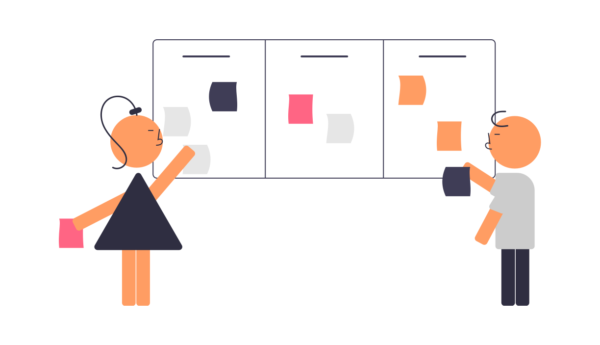Organizations are so used to following manual processes and paperwork that they are sometimes overwhelmed to take a leap into workflow automation. When enterprise organizations stumble to manage their employees, processes, and operations, the most offered solution is to automate their processes using workflow automation software. While taking the right step, at the right time rewards your company in umpteen ways, it is natural to wonder where to start and what to automate.
To provide a solution to all your questions, we have compiled a list of 5 phases each company follows in their journey to automate workflows.
Phases of building automated workflows:
1. Spot repetitive tasks
Identifying recurring tasks is an initial and important step to kick off workflow automation. Recurring tasks are the tasks that repeat themselves at regular intervals and occur within teams, between teams, or between individuals in teams. The frequency of these tasks can be weekly, monthly, or sometimes even yearly.

For example:
- Employees submit timesheets every day,
- Manager approves leaves and compensation offs almost every week,
- Admin team selects external vendors for resource supplies almost every week or month.
These types of tasks that occur over and over again can be classified as repetitive tasks.
Repetitive tasks tend to consume a lot of time and resources. Automating the workflows of repetitive tasks tend to reduce the amount of time spent on them, thereby improving process efficiency.
2. Classify decisions and approvals
Decision-making is the pillar of every organization’s operation. The strategy and growth of each organization depend on every decision taken by the management. While complex decisions require your time and attention, routine decisions can be automated using workflow automation software.
Routine decisions can be of different types. Choosing a purchase order based on the quoted price or shipping the product based on due dates are decisions that do not require manual attention each time. Such decisions are fit to automate.

Approvals occupy a majority of our work tasks. We either seek approvals from senior members of our organization or provide approvals to other employees. Approvals might seem mundane as they are performed almost every day. Approving leaves, reimbursements, budgets, purchase orders, etc, are some of the tasks that obscure our attention.
Approvals and decisions are often assigned to senior members of the company. Indulging themselves in such mundane tasks rids the company off some valuable intelligence and expertise. Automating these tasks is a smart move for effective management.
Along with repetitive tasks, approvals, and decisions, you can also classify computations, emailing, and database updates to automate.
3. Decide user privilege
Every employee in your company is assigned a position. Depending on this position, they are assigned a set of responsibilities within your organization. Similar to this, workflow automation platforms allow you to assign privileges for each employee to perform actions in the software.

For instance, either leads or managerial level users handle approval related tasks. A task holding the customer’s confidential data or personal information, is viewable only for relevant employees and not exposed to all employees.
User privileges ensure that only entitled users handle your company’s data. Not every user can view every other task, thereby restricting access and reducing clutter. This promotes data security and protects confidential data and actions.
Ensure that you decide the privilege of every employee in your organization to assign while automating workflows.
4. Reuse available data
The current manual process you follow in your company might have involved some minimal usage of software like spreadsheets, documents, or slide decks. Any such data available in other documents can be reused while digitizing your workflows so that you don’t have to start from scratch.
While facing a blank workflow editor might seem intimidating, it is solved by reusing the available data. This also reduces the task of digitizing the available data again.
Existing data is reused by importing the files to your workflow automation software. Most automation platforms support import from spreadsheets or documents. Ensure you perform imports before you start automating.

5. Structure the workflow
The fifth and final phase in workflow automation is to structure the workflow. Since this step is the heart of automation, expect to take a few weeks to months to arrive at it. Remember, designing a workflow is a process in itself. It requires quite a few attempts to finalize the perfect workflow. But, we are here to help!
Initially, put together all the steps of the workflow and sketch a rough draft. Also try to accommodate questions like, ‘Who is responsible for each step?’, ‘Who approves each step?’, ‘Who completes the process and declares it done?’. All of these questions help you gain visibility into the process.
Once a rough draft is complete, deploy the process and try to perform actions from the end-user perspective. If you find ways in which you could improve the process, go back to the draft and make changes to it. You always have the scope of improving the workflow.

After a bunch of such trials and errors, your workflow is all set to launch (Viola!).
Digital workflow automation using Yoroflow
If you are looking to automate your company’s processes, Yoroflow is your one-stop destination. From analyzing your company’s processes to supporting you onboard with automated workflows, Yoroflow provides a wide platform where a wide range of tasks are automated.
You can visualize your process, monitor its efficiency, improvise the functioning, and also lets your employees can gain enough process knowledge using Yoroflow. Along with improving productivity and efficiency, automating workflows also provides your company with a competitive advantage and innovative edge.
In addition to that, we promise a straight forward, one-time set up that saves your productive time and makes the initial time spent on automation well worth the productivity you attain.
If you are looking to achieve more with less and don’t know where to start, automating your process workflows is your go-to place.




